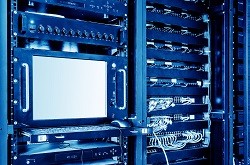Modelling energy efficiency for the next generation of microchips
EU-funded scientists have carried out simulations from the nanoscale to device level to determine energy consumption of microchips and Light Emitting Diodes, or LEDs, to pave the way for a more energy-efficient future generation of electronic devices and lighting. As internet data traffic grows exponentially every year, it sucks in more energy for communications whether via smart phones, tablets or PCs, with current energy usage estimated at 5 % to 10 % of all electricity used globally. Every query on an internet search engine like Google accesses a huge data centre of networked computers. The interconnections and the transistors in the microchips already consume so much energy that managing heat levels created by the components has become a major design issue for industry. ‘The internet is already beginning to make unsustainable global energy demands, which will only get worse with the development of the Internet of Things,’ says Professor Eoin O’Reilly, project coordinator for the DEEPEN (From Atom-to-Device Explicit simulation Environment for Photonics and Electronics Nanostructure) project. ‘If energy efficiency does not improve, you can extrapolate that within, say, 15 years, it will be 50 % of all energy use and this begins to look unsustainable,’ he adds. The project team have been simulating energy consumption in microchip components and LEDs to model energy efficiency. However, as components shrink to the nanoscale – sometime to just 50-100 atoms wide - simulations that traditionally assume bulk or average properties for the semiconductor materials cannot provide an accurate model of energy use. The DEEPEN partners involving researchers, software developers, experts in simulation and its application to device design, as well as manufacturing industry partners such as Osram in Germany, one of the world’s largest LED producers, conducted simulations at both the device and the atomistic level, developing a ‘library’ of material properties and their changes at the different scales. ‘Nanoscale behaviour becomes more important as devices shrink in scale,’ says Prof O’Reilly, of the Tyndall National Institute in Cork, Ireland. ‘At the smallest scale you can describe electronic properties very accurately but it is very expensive in terms of time and computing memory.’ So, DEEPEN experts worked together over three years to devise multiscale simulations using different computer software codes for various problems and then linked the codes together. For LEDs ‘our simulations found that local atomic effects are really important to understand the light emission characteristics of green and blue LEDs. These local atomic effects have been ignored up till now in trying to model (energy efficiency) of devices,’ Prof O’Reilly says. With transistors – the semiconductor devices within microchips which transfer electronic signals using electrical power - traditional energy efficiency modelling treated the devices as having average properties. ‘But in our project, for the first time, we were able to link the very sophisticated description of the atomic properties of the active region with the higher-level treatment of the rest of the device,’ he says. The linked models, drawn up with input from other projects in the European Multiscale Modelling Cluster to create new standards and processes for such coding, will be used to improve device capability design. ‘We are now in a much better position to provide accurate design guidelines to the semiconductor industry and support its ongoing research efforts in energy-efficient nanoelectronic devices,’ Prof O’Reilly concludes.
Keywords
DEEPEN, simulation, energy, energy efficiency, lighting photonics, nanotechnology



